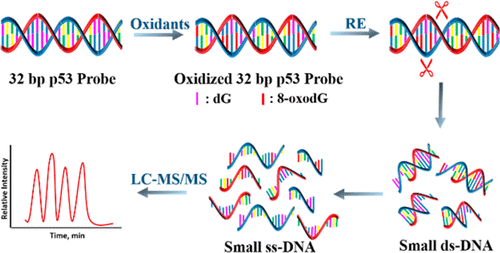当前位置:
X-MOL 学术
›
Anal. Chem.
›
论文详情
Our official English website, www.x-mol.net, welcomes your
feedback! (Note: you will need to create a separate account there.)
Direct LC-MS/MS Detection of Guanine Oxidations in Exon 7 of the p53 Tumor Suppressor Gene
Analytical Chemistry ( IF 6.7 ) Pub Date : 2017-11-22 00:00:00 , DOI: 10.1021/acs.analchem.7b03487 Di Jiang 1 , Spundana Malla 1 , You-jun Fu 1 , Dharamainder Choudhary 2 , James F. Rusling 1, 2, 3, 4
Analytical Chemistry ( IF 6.7 ) Pub Date : 2017-11-22 00:00:00 , DOI: 10.1021/acs.analchem.7b03487 Di Jiang 1 , Spundana Malla 1 , You-jun Fu 1 , Dharamainder Choudhary 2 , James F. Rusling 1, 2, 3, 4
Affiliation

|
Oxidation of DNA by reactive oxygen species (ROS) yields 8-oxo-7,8-dihydroguanosine (8-oxodG) as primary oxidation product, which can lead to downstream G to T transversion mutations. DNA mutations are nonrandom, and mutations at specific codons are associated with specific cancers, as widely documented for the p53 tumor suppressor gene. Here, we present the first direct LC-MS/MS study (without isotopic labeling or hydrolysis) of primary oxidation sites of p53 exon 7. We oxidized a 32 base pair (bp) double-stranded (ds) oligonucleotide representing exon 7 of the p53 gene. Oxidized oligonucleotides were cut by a restriction endonuclease to provide small strands and enable positions and amounts of 8-oxodG to be determined directly by LC-MS/MS. Oxidation sites on the oligonucleotide generated by two oxidants, catechol/Cu2+/NADPH and Fenton’s reagent, were located and compared. Guanines in codons 243, 244, 245, and 248 were most frequently oxidized by catechol/Cu2+/NADPH with relative oxidation of 5.6, 7.2, 2.6, and 10.7%, respectively. Fenton’s reagent oxidations were more specific for guanines in codons 243 (20.3%) and 248 (10.4%). Modeling of docking of oxidizing species on the ds-oligonucleotide were consistent with the experimental codon oxidation sites. Significantly, codons 244 and 248 are mutational “hotspots” in nonsmall cell and small cell lung cancers, supporting a possible role of oxidation in p53 mutations leading to lung cancer.
中文翻译:

直接LC-MS / MS检测p53肿瘤抑制基因第7外显子中的鸟嘌呤氧化
DNA被活性氧(ROS)氧化产生8-oxo-7,8-dihydroguanosine(8-oxodG)作为主要的氧化产物,可导致下游的G到T转换突变。DNA突变是非随机的,特定密码子上的突变与特定癌症相关,如p53抑癌基因所广泛报道的。在这里,我们展示了p53外显子7主要氧化位点的首次直接LC-MS / MS研究(无同位素标记或水解)。我们氧化了32个碱基对(bp)的双链(ds)寡核苷酸,它们代表了p53外显子7的外显子。 p53基因。通过限制性核酸内切酶切割氧化的寡核苷酸以提供小链,并使8-oxodG的位置和数量可以直接通过LC-MS / MS确定。儿茶酚/ Cu 2+两种氧化剂在寡核苷酸上的氧化位点定位并比较/ NADPH和Fenton试剂。243、244、245和248位密码子中的鸟嘌呤最常被儿茶酚/ Cu 2+ / NADPH氧化,相对氧化分别为5.6、7.2、2.6和10.7%。Fenton试剂的氧化对鸟嘌呤的密码子243(20.3%)和248(10.4%)更具特异性。氧化物种在ds-寡核苷酸上的对接建模与实验密码子氧化位点一致。重要的是,密码子244和248是非小细胞和小细胞肺癌的突变“热点”,支持氧化在导致肺癌的p53突变中的可能作用。
更新日期:2017-11-22
中文翻译:

直接LC-MS / MS检测p53肿瘤抑制基因第7外显子中的鸟嘌呤氧化
DNA被活性氧(ROS)氧化产生8-oxo-7,8-dihydroguanosine(8-oxodG)作为主要的氧化产物,可导致下游的G到T转换突变。DNA突变是非随机的,特定密码子上的突变与特定癌症相关,如p53抑癌基因所广泛报道的。在这里,我们展示了p53外显子7主要氧化位点的首次直接LC-MS / MS研究(无同位素标记或水解)。我们氧化了32个碱基对(bp)的双链(ds)寡核苷酸,它们代表了p53外显子7的外显子。 p53基因。通过限制性核酸内切酶切割氧化的寡核苷酸以提供小链,并使8-oxodG的位置和数量可以直接通过LC-MS / MS确定。儿茶酚/ Cu 2+两种氧化剂在寡核苷酸上的氧化位点定位并比较/ NADPH和Fenton试剂。243、244、245和248位密码子中的鸟嘌呤最常被儿茶酚/ Cu 2+ / NADPH氧化,相对氧化分别为5.6、7.2、2.6和10.7%。Fenton试剂的氧化对鸟嘌呤的密码子243(20.3%)和248(10.4%)更具特异性。氧化物种在ds-寡核苷酸上的对接建模与实验密码子氧化位点一致。重要的是,密码子244和248是非小细胞和小细胞肺癌的突变“热点”,支持氧化在导致肺癌的p53突变中的可能作用。











































 京公网安备 11010802027423号
京公网安备 11010802027423号